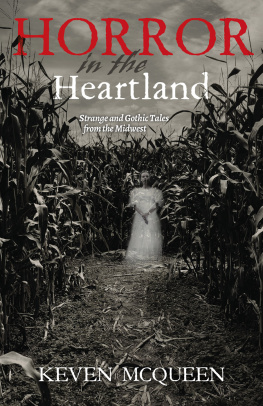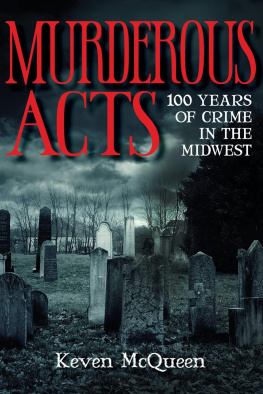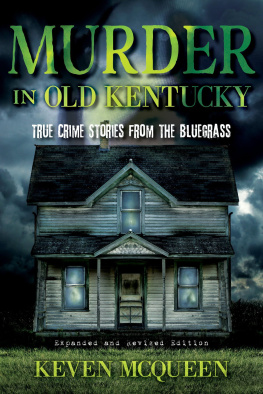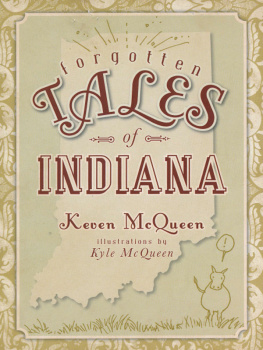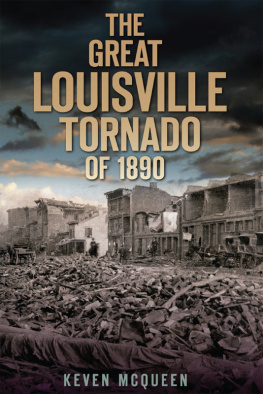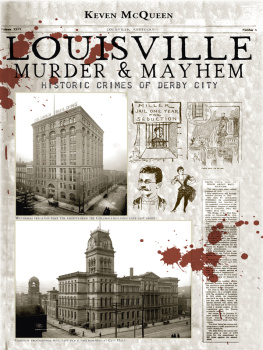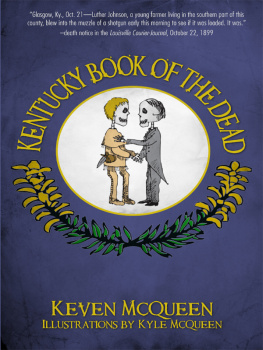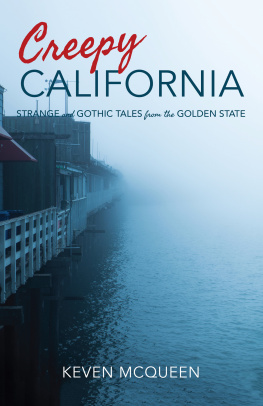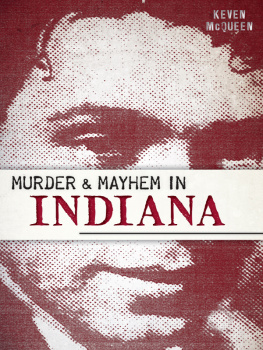This book is a publication of
Quarry Books
an imprint of
Indiana University Press
Office of Scholarly Publishing
Herman B Wells Library 350
1320 East 10th Street
Bloomington, Indiana 47405 USA
iupress.org
2021 by Keven McQueen
All rights reserved
No part of this book may be reproduced or utilized in any form or by any means, electronic or mechanical, including photocopying and recording, or by any information storage and retrieval system, without permission in writing from the publisher. The paper used in this publication meets the minimum requirements of the American National Standard for Information SciencesPermanence of Paper for Printed Library Materials, ANSI Z39.481992.
Manufactured in the United States of America
First printing 2021
Library of Congress Cataloging-in-Publication Data
Names: McQueen, Keven, author.
Title: Murder in old Kentucky : true crime stories from the Bluegrass / Keven McQueen.
Description: Expanded and revised edition. | Bloomington, Indiana : Quarry Books, [2021] | Includes bibliographical references.
Identifiers: LCCN 2021001568 (print) | LCCN 2021001569 (ebook) | ISBN 9780253057488 (paperback) | ISBN 9780253057495 (ebook)
Subjects: LCSH: MurderKentuckyCase studies.
Classification: LCC HV6533.K4 M38 2021 (print) | LCC HV6533.K4 (ebook) | DDC 362.88/29309769dc23
LC record available at https://lccn.loc.gov/2021001568
LC ebook record available at https://lccn.loc.gov/2021001569
Dedicated to my uncle J. L. Casteel, who loves history.
CONTENTS
P REFACE
A CKNOWLEDGMENTS
I NTRODUCTION TO THE E XPANDED 2021 E DITION
K ENTUCKY S F IRST G REAT M URDER
R ICHARD S HUCK C ONFESSES A LL AND T HEN S OME
A M OB T EACHES M R . K LEIN THE E RROR OF H IS W AYS
P LAYING I T C OOL !
C OLONEL B UFORD B EGS TO D IFFER WITH J UDGE E LLIOTT
A N A RGUMENT FOR THE I NVOLUNTARY C OMMITMENT OF THE C RIMINALLY I NSANE
A N A RSONIST WITH A G RUDGE
C OLD C ASE F ILE , 1866
A Q UESTION OF S ANITY
T HE H ANGING OF J OHN V ONDERHEIDE
A R EGULAR K ILLING M ACHINE
A L ITTLE F UN : T HE A SHLAND T RAGEDY
A T WO -F ISTED P ROFESSOR R EFUSES TO T AKE N O FOR AN A NSWER
M OSES C ATON , F AMILY M AN
K NOX C OUNTY A TROCITY
A P OSSIBLE P OISONER AND A D EFINITE O NE
T HE S MART M URDERS , OR C HOOSE Y OUR F RIENDS W ISELY
H OW N OT TO S PEND H OMECOMING W EEK
T HE S HOWERS -M OORE T RAGEDY
O N THE B ENEFITS OF K EEPING O NE S T EMPER
A H EART IN THE W RONG P LACE
T WO FOR THE C HAIR
M URDER ON A C OLLEGE C AMPUS
S AME S TORY , D IFFERENT E NDINGS
T HE H EAD ON THE M OUND
B IBLIOGRAPHY
READERS OF MY PREVIOUS BOOKS MIGHT HAVE NOTICED THAT MY sense of humor is as dark as the inside of a badger and that I find murder an irresistible subject matter. Sometimes these idiosyncrasies stroll arm in arm. I long ago ceased apologizing. After all, murder is the most dramatic of all human actions and is one of the few topics everyone finds interesting. Most of us can identify with Hume Cronyns character in Alfred Hitchcocks film Shadow of a Doubt, a mild-mannered and clerkish fellow without a drop of malice in his personality who nevertheless is unable to refrain from reading about real murders and discussing their finer points with fellow aficionados. Mother Teresa was so delighted by murder mysteries, the gorier the better, that she collected them by the crateload. (I just made that up, but it proves my point.) But if true crime stories are fascinating, so is history in general, making a historical true crime story irresistible to many readers. I have finally decided to give free rein to my impulses and write a book that is entirely concerned with murdera true crime book, concerning only atrocities that took place in Kentuckys distant past.
The history of the commonwealth provides many such stories, for Kentucky was a violent place. Legend has it, though erroneously, that the states name is an Indian word meaning dark and bloody ground. (I have it on good authority that Kentucky is actually an Indian word for basketball.) From the early depredations of the Harpe brothers to innumerable lynchings to the moonshine wars and mountain feuds of the late nineteenth century, our state has long had a reputation for being a place where people settle disputes with violence. The Kentucky Gazette of April 12, 1838, contains a typical item suggesting that even the upper classes were not immune. Note the sarcasm of the final line: R. A. Ferguson Esq., who for a few weeks edited the Kentucky Gazette, had a fight in the county of Hickman, with a brother lawyer by the name of Rivers. Rivers proved the better man, and beat Ferguson severely. Ferguson procured a rifle and shot Rivers dead. The brother of Rivers then shot Ferguson with a rifle, which not proving instantly fatal, advanced with a pistol and dispatched him. Our law makers have done much to prevent the shedding of human blood.
The violence in Kentucky was a running joke in the nations press from the 1870s to the early twentieth century. Madison County averaged so many murders per year that headlines such as Another Madison Murder were common. A specimen headline from a September 1877 issue of the Kentucky Gazette: BLOODY RICHMOND. Only Four Men Killed. Its Well, Twas No Worse. In December 1878, Richmond editor French Tipton wrote an almost comically lengthy article for the New York Herald detailing the mayhem that had occurred in Madison County only over the previous couple of years. Several years later, Tipton himself would be murdered.
By the 1880s, Bloody Breathitt County had acquired its lasting nickname. A similar name given to another countyLawless Letcherwas in vogue for a while but never stuck. Rowan County earned such a reputation for anarchy that in January 1888 the state legislature considered abolishing it. Legislators in Frankfort formed a Rowan County Investigating Committee, and the Louisville Courier-Journal predicted, The recommendation to abolish Rowan County will be unanimously approved.... [T]he turbulent factors of Rowan will not alone be scattered, but other counties where lawlessness has at times been rampant will be menaced into reform. Rowan is still with us, so clearly the measure was defeated.
Henry Watterson, legendary editor of the Courier-Journal, theorized that the states major problem was that the legal system was too soft on criminals. There has not been in twenty years a criminal trial in Kentucky which has not illustrated the evils of the extraordinary privileges granted to men accused of crime, he wrote in 1888, foreshadowing the modern victims rights movement. Although Watterson decried the common practice of lynching, he believed that citizens take the law into their own hands when they feel the police are not adequately protecting them: The chief defense of society is Judge Lynch. It is a wholesome dread of the mob that restrains the men of violence, for of the law as administered in our courts they have no fear. He complained also about the states concealed weapons law, which he found hypocritical. We do not punish a man for using his weapon with deadly effect, he wrote, but if caught with it quietly concealed on his person he is to be sent to the penitentiary for two years.... The State, in truth, has no right to take it from him until it has assured to every citizen full protection for life and property.





